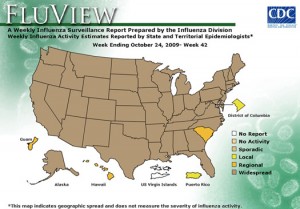CDC 2009 H1N1 Flu: Situation Update 30 October 2009
October 31, 2009 by Da-Chief
Filed under Corpsman.com News, Military Family
Key Flu Indicators
October 30, 2009, 1:30 PM
Each week CDC analyzes information about influenza disease activity in the United States and publishes findings of key flu indicators in a report called FluView. During the week of October 18-24, 2009, a review of the key indictors found that influenza activity continued to increase in the United States from the previous week. Below is a summary of the most recent key indicators:
- Visits to doctors for influenza-like illness (ILI) increased steeply since last week in the United States, and overall, are much higher than what is expected for this time of the year. ILI activity now is higher than what is seen during the peak of many regular flu seasons.
- Total influenza hospitalization rates for laboratory-confirmed flu are climbing and are higher than expected for this time of year. Hospitalization rates continue to be highest is younger populations with the highest hospitalization rate reported in children 0-4 years old.
- The proportion of deaths attributed to pneumonia and influenza (P&I) based on the 122 Cities Report has increased and has been higher than what is expected at this time of year for four weeks now. In addition, 22 flu-related pediatric deaths were reported this week; 19 of these deaths were confirmed 2009 H1N1, and three were influenza A viruses, but were not subtyped. Since April 2009, CDC has received reports of 114 laboratory-confirmed pediatric 2009 H1N1 deaths and another 12 pediatric deaths that were laboratory confirmed as influenza, but where the flu virus subtype was not determined.
- Forty-eight states are reporting widespread influenza activity at this time. They are: Alabama, Alaska, Arizona, Arkansas, California, Colorado, Connecticut, Delaware, Florida, Georgia, Idaho, Illinois, Indiana, Iowa, Kansas, Kentucky, Louisiana, Maine, Maryland, Massachusetts, Michigan, Minnesota, Mississippi, Missouri, Montana, Nebraska, Nevada, New Hampshire, New Jersey, New Mexico, New York, North Carolina, North Dakota, Ohio, Oklahoma, Oregon, Pennsylvania, Rhode Island, South Dakota, Tennessee, Texas, Utah, Vermont, Virginia, Washington, West Virginia, Wisconsin, and Wyoming. This many reports of widespread activity are unprecedented during seasonal flu.
- Almost all of the influenza viruses identified so far are 2009 H1N1 influenza A viruses. These viruses remain similar to the virus chosen for the 2009 H1N1 vaccine, and remain susceptible to the antiviral drugs oseltamivir and zanamivir with rare exception.
More on the Situation
- CDC Response
A summary of CDC activities - FluView
A Weekly Influenza Surveillance Report Prepared by the Influenza Division. - International Situation Update
The Southern Hemisphere is in the middle of its flu season, and we have reports of what is happening there - Facts and Figures
A summary of key 2009 H1N1 disease characteristics. - Health Alert Network (HAN) Messages
- Q & A: CDC’s Online Reporting
Background
- Background
Learn about the emergence of the 2009 H1N1 virus in the United States and WHO’s declaration of a novel H1N1 pandemic.








